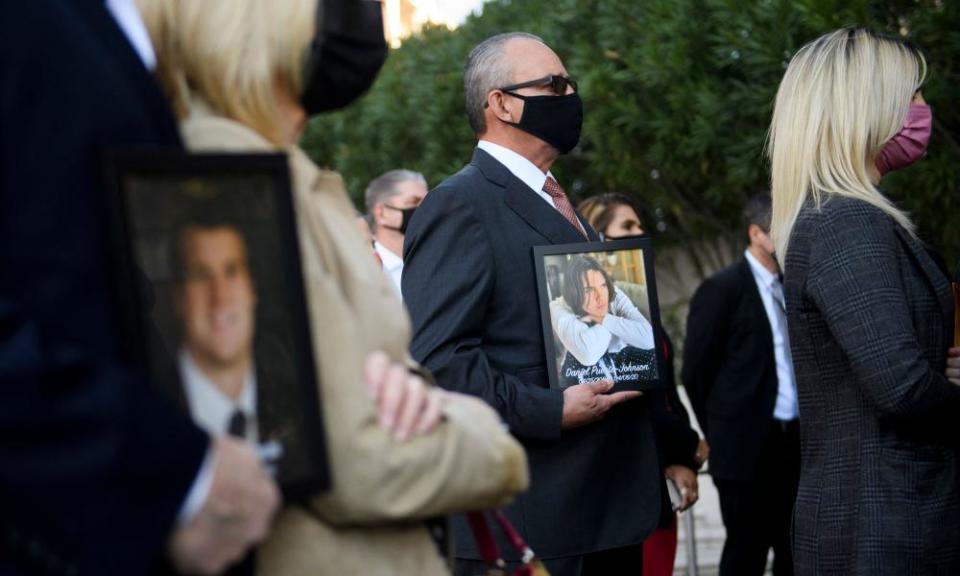Enough fentanyl to kill San Francisco: the new wave of the opioid crisis sweeping California

When San Francisco police seized seven kilos of powder-filled baggies containing the deadly opioid fentanyl last week, the city’s police chief warned the bust contained “enough lethal overdoses to wipe out San Francisco’s population four times over”.
But drug addiction experts say the haul may represent just a tiny fraction of the massive volume of the powerful synthetic drug that is flooding California, after being mostly an east coast phenomenon for years.
The evidence is in the rapidly surging death rates. The number of deaths from fentanyl overdoses jumped by more than 2100% in California in five years, state figures show. Overdoses of synthetic opioids (mostly fentanyl) killed nearly 4,000 residents in the state last year, according to the most recent estimate from the US Centers for Disease Control and Prevention.
In San Francisco, drug users are dying at a rate of nearly two a day, many on the streets of the city’s Tenderloin District. In San Diego, fentanyl is coursing through the homeless population, according to experts and recent media reports. Santa Clara county saw the number of fentanyl deaths more than double last year, KQED reported, with victims on average younger than in previous years.
“Fentanyl has moved west,” said Dr Daniel Ciccarone, a professor specializing in addiction medicine at the University of California, San Francisco. Ciccarone said the lab-made drug was barely seen in western states before 2017. Instead, he said, it used to be distributed by drug trafficking networks supplying the east coast, who often slipped it into heroin supplies without telling users.
In a paper released this month, Ciccarone describes the explosion of accidental overdose deaths occurring west of the Mississippi as part of a “fourth wave” of the opioid crisis.
“Deaths due to fentanyl are rising more quickly in the west now than they are in the east,” Ciccarone said.
In California, the drug is being sold under its own name, as powders or tablets. It’s also being mixed with stimulants, like methamphetamines.
Fentanyl is so powerful that a quantity small enough to fit under a fingernail can be deadly within minutes. Dr Aimee Moulin, a professor of emergency medicine at the University of California, Davis medical center in Sacramento, said she was seeing adolescents as young as 13 overdose on counterfeit opioid pills available for home delivery over the internet.
“The potency is so high that a decimal point difference in the concentration can be lethal,” she said.
“This predates the pandemic,” said David Panush, the head of the consulting firm California Health Policy Strategies, which produced a report concluding fentanyl is “largely responsible for the unprecedented growth in overdose deaths” in California. “The pandemic probably made it worse, but you had these addiction trends that were skyrocketing and fentanyl is like pouring gasoline on the fire.”
Another paper, co-authored by the Stanford University researcher Chelsea Shover, said the west coast may be three years behind on the same horrible trajectory of overdose deaths that overwhelmed the east coast several years ago.
“Given how fentanyl has so dramatically worsened the US overdose death rate while only being pervasive in part of the country, its national spread could make the epidemic significantly worse,” said the report, published in the journal Drug and Alcohol Dependence.
Fentanyl is an attractive product for drug cartels because it can be cheaply manufactured in foreign clandestine laboratories and substituted for more expensive drugs like the white-powdered heroin commonly sold on the east coast or pressed into counterfeit pills sold as OxyContin or Percocet, according to the 2020 National Drug Threat Assessment from the US Drug Enforcement Administration. The Sinaloa cartel and Jalisco New Generation cartel from Mexico have been taking over production and distribution from prior sources, which included China, the report said.
The San Francisco police department’s drug bust operation in Oakland on 3 June, which resulted in five arrests, the seizure of seven kilos (16lb) of fentanyl, $45,000 in cash and two unregistered “ghost guns”, was only the latest in a recent string of major fentanyl seizures in northern California.
“Fentanyl remains the primary chemical culprit in the record-shattering number of fatal overdoses plaguing our city, the San Francisco police chief, Bill Scott, said in a statement.
Related: Revealed: how Mexico's Sinaloa cartel has created a global network to rule the fentanyl trade
“And the recovery of semi-automatic ghost guns along with this haul of deadly drugs most likely intended for the Tenderloin is ominous.”
Yet Ciccarone said he has little faith that the busts are cutting the supply on the street by much.
“When I hear of these busts, I have a sense of dread,” he said. “I see it as a marker that the supply has gone up.”
He believes that more resources need to be put into curtailing the demand for drugs by treating addiction and dealing with the root causes behind overdose risk, including incarceration, unstable housing, economic stagnation and class-based despair.
“We simply have not gotten to a proportional response to what amounts to an uncontrolled crisis,” he said, noting that though the nation has poured resources into combating the opioid crisis, deaths are still going up nationally, driven in part by the surge in west coast overdoses. “There still aren’t enough drug treatment slots in America.”
Dr Moulin, who is spearheading a program to make it possible for drug users to easily get treatment at any hospital in California, agreed.
“Opioid use disorder is highly treatable and we have highly effective medications,” she said. “We just need to have an all-hands-on-deck approach.”

 Yahoo Finance
Yahoo Finance 